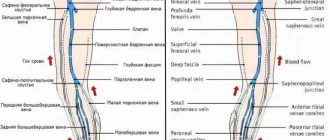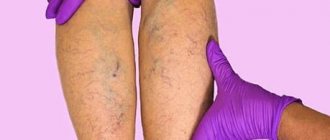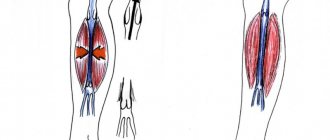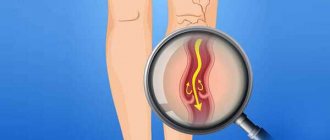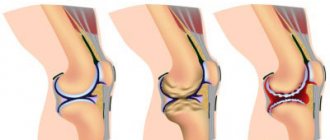Obliterating atherosclerosis is one of the main diseases that causes impaired blood supply to the lower extremities. The disease is associated with the accumulation of cholesterol in the artery wall, forming plaques that block the lumen of the artery. The arteries become hard and their patency is impaired. This pathology can lead to thrombosis of the affected artery with the development of acute ischemia. The disease usually develops in old age, often against the background of diabetes mellitus, although now relatively young patients also turn to a vascular surgeon.
Lack of blood supply leads to dysfunction of the muscles of the limb, this is manifested by fatigue when walking for some distance, and with severe decompensation of blood circulation, gangrene of the leg can develop.
Treatment of atherosclerosis at the Innovative Vascular Center
Our center was created as a clinic for modern treatment of atherosclerosis and its complications. In our clinic you can consult an experienced vascular surgeon and undergo the necessary instrumental examination. Receive recommendations for conservative treatment of uncomplicated vascular lesions, but the main thing is to fully cure critical ischemia with the help of vascular surgery.
The methods of vascular surgery used in our clinic have no analogues in Russia in terms of their effectiveness in the treatment of critical ischemia against the background of obliterating atherosclerosis. We focus on minimally invasive and microsurgical interventions, which have not yet become widespread in our country. We are able to save a leg in case of critical ischemia due to atherosclerotic blockage in 98% of all patients. We achieve such results thanks to reasonable approaches to treatment, impeccable attitude towards the interests of our patients, collegial decisions taking into account the opinions of related specialists and excellent diagnostic and treatment equipment.
Risk groups and concomitant diseases for atherosclerosis of the vessels of the lower extremities:
- male gender (distribution of disease: 85% men, 15% women);
- age 50 years and older, although the disease is getting younger;
- hereditary factor;
- smoking;
- diabetes;
- hypertension (high blood pressure);
- high cholesterol (infatuation with fatty foods);
Signs (symptoms) and stages of the disease
The main symptom signaling the onset of blockage of the arteries of the lower extremities is the so-called “intermittent claudication.”
When walking, pain appears in the muscles of the legs, which is characterized as “fettering”, “squeezing”, the leg seems to “go wooden”. The pain intensifies when running or climbing stairs. The location of the pain zones depends on the location of the compressed (affected) areas of the arteries. The most common pain is in the calf muscles. But pain can also occur in the muscles of the thighs and buttocks, which indicates damage to large arteries: the iliac, abdominal aorta. The extent to which circulation is impaired can be understood by the distance that the patient travels before the first attacks of pain appear.
Stages 1 and 2 : pain in the lower extremities after 500-1000 meters of walking, the toes go numb, the leg is cold, the skin of the lower leg and foot turns pale.
Stage 3 : pain occurs when walking short distances, up to 100 meters, hair loss on the lower leg, foot and toes, the skin acquires a purplish-bluish tint, wounds heal poorly, nail growth slows down, and deformation occurs.
Stage 4 : the legs hurt at rest, in a horizontal position, the pain temporarily subsides when lowering the legs down, then intensifies. Necrosis and tissue necrosis begin, non-healing trophic ulcers appear. Men experience impotence.
Stage 5 : gangrene of the leg develops, starting from the foot. Only surgical intervention and limb amputation can help save the patient’s life.
Atherosclerosis of the lower extremities occurring against the background of diabetes mellitus is especially dangerous. The disease progresses rapidly and leads to necrotic lesions and gangrene in just a matter of days and even hours.
Diagnosis of atherosclerosis of the lower extremities in our Center
Only comprehensive diagnostics using modern diagnostic systems provides reliable information on what stage of the disease the patient is at and what forms and methods of treatment will be most effective.
During the initial free consultation, the patient is interviewed and examined, complaints are listened to, visible changes in the skin are noted, and lesions are identified.
Further diagnosis of arteries is carried out using non-invasive painless methods: ultrasound scanning (ultrasound duplex scanning of the vessels of the lower extremities).
The walls of blood vessels are examined and assessed by a specialist, the speed of blood flow is established, and obstacles that disrupt healthy circulation are identified.
In severe forms of the disease, tests and additional diagnostic methods are prescribed (CT angiography of leg vessels, measurement of partial pressure of oxygen in tissues) in order to assess the patient’s condition in detail before surgery.
Modern treatment of atherosclerosis of the lower extremities
In the initial stages, it is possible to combine the use of medications and the use of physiotherapy, which includes a set of exercise therapy exercises and dosed (short) walking.
If there is a slight partial narrowing of the artery section, stenting is used: the affected artery is punctured, a catheter with a stent is inserted, which, using a compressed air cylinder, opens, expanding the narrow section and is fixed, thereby restoring blood circulation.
In case of serious disruption of blood flow, when the blocked areas of the vessels are prolonged, surgical methods are used to restore blood circulation:
- prosthetics or bypass surgery with a synthetic prosthesis (alloprosthesis);
- prosthetics or bypass with an autologous vein: using your own vein, a bridge is created, a bypass from the proximal to the distal end, that is, bypassing the blocked area;
Profundoplasty is a surgical correction effective in terms of clinical results, which is performed for patients with occlusion of the superficial femoral artery and stenosis of the deep femoral artery with chronic ischemia of the lower extremities of severe stages. For this, endarterectomy from the deep femoral artery and angioplasty with a patch are used, which can be the patient’s vein or artery or special artificial synthetic substitutes. Today, profundoplasty is a method with highly proven effectiveness, which can be used to reduce the degree of ischemia and reduce the risk of limb amputation.
What to do for atherosclerosis of the arteries of the lower extremities
The first thing you need to know. Atherosclerosis is not a death sentence. Despite the fact that the vessels cannot be restored to their original form, with timely access to a vascular surgeon, the patient has every chance to continue to live and work fully. But even with serious changes and lost time, there are great hopes for the successful finalization of the process, which consists of preserving the lower extremities while following the doctor’s simple recommendations in the postoperative period. In our clinic, qualified vascular surgeons literally rescue people from the other world who were rejected by other medical institutions. We urge you not to be indifferent to your health, get free consultation, and, if necessary, stop atherosclerosis using modern methods of vascular surgery. Your operation can be performed free of charge, as it is high-tech assistance and is subject to quotas from budget funds.
Diagnostics
Diagnostic measures include taking an anamnesis, examination by a vascular surgeon, and a complex of hardware and laboratory tests. Differential diagnosis also plays an important role, since the symptoms of obliterating atherosclerosis are in many ways similar to Raynaud's syndrome, Monkeberg's sclerosis, sciatic nerve neuritis and a number of other pathologies.
Hardware research includes:
- Duplex scanning of peripheral arteries is a technique that combines the capabilities of ultrasound, which allows you to visually assess the condition of the walls of blood vessels, and Doppler studies of blood flow using contrast agents.
- Computed angiography – allows you to obtain an accurate three-dimensional image of the arterial system.
- Peripheral arteriography is an X-ray examination of the peripheral arteries of the lower extremities with the introduction of a contrast agent. Helps identify aneurysms and other arterial pathologies.
- To assess the adequacy of blood flow in the arteries of the lower extremities, the ankle-brachial index is measured. It is determined by dividing the blood pressure reading in the legs by the same reading in the arms.
A complex of hardware studies allows you to assess the degree of vascular patency and the level of narrowing of the lumen of the arteries, identify problems with the blood supply to the diseased limb, the severity and extent of the lesion.
Laboratory tests are aimed at determining the quality characteristics of blood and excluding diseases with similar symptoms:
- Biochemical analysis to determine lipid levels, including total cholesterol. A lipidogram allows you to identify disturbances in the process of fat metabolism and assess the risk of developing vascular pathologies.
- Assessing the level of glycated hemoglobin to determine the average blood glucose level and exclude the possibility of arterial damage due to diabetes.
- Comprehensive assessment of blood clotting indicators in the presence of a history of thrombosis or blood problems in close relatives.
- The results of a comprehensive study make it possible to assess the degree of occlusion of the arteries of the lower extremities and develop an individual treatment regimen.
Symptoms
The development of atherosclerosis can occur over a long period of time and is completely asymptomatic. The first signs of the disease may appear only in adulthood. For many patients, symptoms do not occur until the vessel lumen diameter has decreased by 60%.
Sometimes manifestations of atherosclerosis can resemble a broken callus. Source: Jonathan Moore / (Creative Commons Attribution 3.0 Unported license)
Scheme of laser therapy for OASNK:
| № | Impact area | Frequency | Exposure (time) |
| 1 | Pulsation zone of the femoral artery. | 50 Hz | 2 minutes for each zone |
| 2 | Zones along the anterior-inner surface of the thigh and lower leg, with an interval between impact zones of about 10 cm. | ||
| 3 | Zones on both sides of the Achilles tendon. | ||
| 4 | Middle of the calf muscle. | ||
| 5 | Popliteal fossa. | ||
| 6 | Paravertebral effect on the lumbosacral region. | MOVE | 4 minutes on each side |
A course of laser therapy for OASNK consists of 15-20 daily procedures.
The procedures are carried out alternately: one day on the left leg, one day on the right leg.
Sessions are held every other day or daily.
Laser therapy courses are recommended to be carried out 3-4 times a year.
If necessary, on the recommendation of a doctor, 3 courses of laser therapy are carried out with an interval of 1 month according to the above scheme.
Surgical treatment is used in cases where conservative treatment is ineffective and the disease progresses. Common types of surgical treatment are bypass surgery, prosthetics, endarterectomy, stenting, balloon angioplasty and others.
Factors influencing the development of atherosclerosis
- Increase in blood cholesterol over 250 mg%.
- High blood pressure.
- Hormonal factors. For example, it has been proven that estrogens inhibit the development of atherosclerosis.
- Social factors play an important role in the development of atherosclerosis. The example of South Korea shows the connection between the development of atherosclerosis and the level of stress. Atherosclerosis is constantly being discovered in war-affected residents, despite a generally healthy lifestyle.
- Obesity and physical inactivity.
- Hereditary factor.
- Imbalance of the blood coagulation and anticoagulation systems.
Prognosis and prevention
Source: PhotoMIX Company: Pexels
The effectiveness of treatment and the overall prognosis for obliterating atherosclerosis depend on the time of initiation of therapy, the degree of arterial damage and the presence of concomitant pathologies. Therapy is particularly difficult when other vessels, cerebral or coronary, are simultaneously affected.
The most dangerous complication of the disease is gangrene, which has a high probability of death. Its development can only be prevented by emergency amputation of the affected limb.
Prevention measures are aimed at reducing the risk of developing atherosclerosis and include the following recommendations:
- normalize your diet and give up high-fat foods;
- do not smoke or drink alcoholic beverages;
- devote time to moderate physical activity, such as swimming, cycling or even just walking;
- keep your feet clean;
- wear comfortable shoes with low heels;
- Avoid injuries and cuts to the skin on your legs.
Timely treatment can stop the development of the pathological process and significantly improve the patient’s quality of life.
Causes
The main cause of the disease is systemic atherosclerosis. The formation of cholesterol plaques on the walls of blood vessels of the lower extremities is associated with the same pathological mechanisms that cause vascular damage in any other place.
Factors in the development of atherosclerosis:
- dyslipidemia – an imbalance in the content of fats (triglycerides and lipoproteins) in the blood;
- weakness and loss of firmness and elasticity of the vessel wall;
- disruption of cellular metabolism;
- genetic predisposition.
Risk factors for developing pathology:
- gender – men suffer from atherosclerosis several times more often than women;
- age – the disease usually begins to progress after 40 years;
- smoking - nicotine has a vasoconstrictor property and negatively affects the condition of the walls of blood vessels;
- overweight;
- unhealthy diet – a large amount of fat in the diet worsens lipid metabolism and contributes to the formation of cholesterol deposits;
- sedentary lifestyle;
- hormonal disorders;
- unfavorable environmental conditions.
Source: freepic.diller / ru.freepik.com
People with chronic diseases are predisposed to obliterating atherosclerosis: hypertension, endocrine disorders, ischemia and a number of others.
Vein diseases
Leg pain is accompanied by:
- Varicose veins;
- phlebitis and thrombophlebitis;
- postthrombophlebitic syndrome.
Varicose veins
This disease is widespread and is a very pressing problem in medicine and cosmetology.
Find out more about the promotion >>>
Phlebitis and thrombophlebitis
Phlebitis is inflammation of a vein. Thrombophlebitis is a complication of phlebitis or varicose veins of the lower extremities. With thrombophlebitis, a blood clot forms in the inflamed vein. Pain is a concern and swelling of the legs is possible.
Deep vein thrombosis is fraught with complications, the most dangerous of which are venous gangrene of the limb (with high blockage and blockage of all outflow pathways of venous blood) and pulmonary embolism. The risk of thromboembolism is highest in the presence of an unfixed - floating thrombus. The larger the detached fragment of the blood clot, the greater the likelihood of an unfavorable outcome, including death.
A common complication of deep vein thrombophlebitis is postthrombophlebitis syndrome.
Angiography of vessels of the lower extremities
Angiography of the extremities (peripheral angiography) is a minimally invasive research method performed under local anesthesia. It allows you to visualize the vessels of the extremities and accurately determine areas of narrowing and blockage of blood vessels.
The method involves introducing an iodine-containing dye into the vessel under study. The introduction is made using a catheter through the groin area. The dye is clearly visible under X-rays, which allows you to analyze all the features of blood circulation.
Angiography can cause the following complications:
- Damage to the vessel being examined;
- Negative effects of contrast agent on the kidneys;
- Allergic reaction to contrast agent;
- Hematomas, bruises, nerve damage at the site of catheter insertion.
Important: Due to the potential for complications and radiation exposure, this procedure is not recommended for pregnant women. Scientists still do not fully understand how radiation can affect the fetus, which is why pregnant women are usually prescribed other procedures.
Additionally, the coronary arteries and heart are examined to detect heart failure and other heart diseases.
Complications
If atherosclerosis is not treated properly, a person may develop the following complications:
- Gangrene (tissue death);
- Ischemic ulcers on the legs;
- Impotence.
In the worst case scenario, amputation of the limb may be indicated.
Because cardiovascular diseases are closely related to each other, developing one disease can significantly increase your chances of developing another. Therefore, atherosclerosis can also cause the development of:
- Coronary heart disease;
- Stroke;
- Angina pectoris;
- Heart attack.
Doppler ultrasound
Ultrasound examination is the most common diagnostic method. This study is the first step towards studying human vascular diseases. Based on the ultrasound results, a further diagnostic and treatment plan is built.
Important: Smoking is prohibited before the ultrasound procedure. Smoking causes vasoconstriction, which leads to incorrect test results. And in general, before any diagnosis and testing, you should ask your doctor in advance how to prepare. This will help avoid unpleasant situations at the reception.
This is approximately how an ultrasound of the foot goes. Source: Vascular Online Training VOT / YouTube
Using ultrasound, it is possible to examine all changes in blood vessels, the degree of their narrowing or the presence of stenosis. Determine the localization and duration of atherosclerotic processes.
